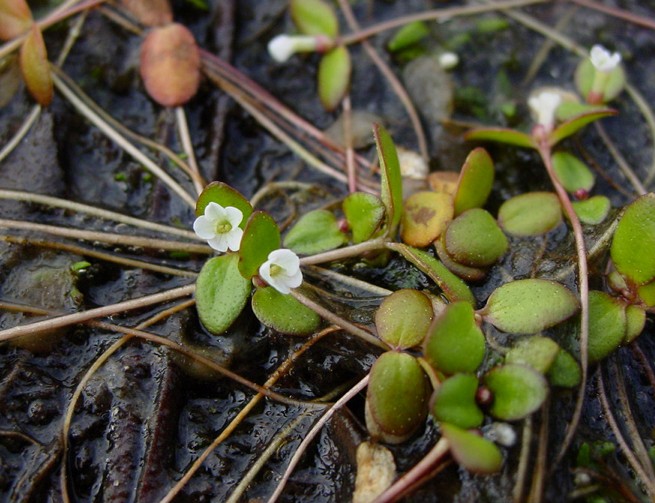Classification System: APG IV
Superregnum: Eukaryota
Regnum: Plantae
Cladus: Angiosperms
Cladus: Eudicots
Cladus: Core eudicots
Cladus: Asterids
Cladus: Lamiids
Ordo: Lamiales
Familia: Plantaginaceae
Tribus: Gratioleae
Genus: Gratiola
Species: Gratiola amphiantha
Name
Gratiola amphiantha D.Estes & R.L.Small, Syst. Bot. 33(1): 181. 2008 [26 Feb 2008], nom. nov.
Synonyms
Replaced synonym
Amphianthus pusillus Torr., Ann. Lyceum Nat. Hist. New York 4: 82. 1837.
Typus: U.S.A. Georgia: “In small excavations on flat rocks, where the soil is wet during the flowering season; Newton (now part of Rockdale) County, Georgia” (according to protologue), 1836, Leavenworth s.n. (Holotypus: NY-00067822).
References
Primary references
Estes, D. & Small, R.L. 2008. Phylogenetic Relationships of the Monotypic Genus Amphianthus (Plantaginaceae Tribe Gratioleae) Inferred from Chloroplast DNA Sequences. Systematic Botany 33(1): 176–182. DOI: 10.1600/036364408783887375 JSTOR PDF Reference page.
Links
International Plant Names Index. 2018. Gratiola amphiantha. Published online. Accessed: Nov. 7 2018.
Tropicos.org 2018. Gratiola amphiantha. Missouri Botanical Garden. Published online. Accessed: 7 Nov. 2018.
Hassler, M. 2018. Gratiola amphiantha. World Plants: Synonymic Checklists of the Vascular Plants of the World In: Roskovh, Y., Abucay, L., Orrell, T., Nicolson, D., Bailly, N., Kirk, P., Bourgoin, T., DeWalt, R.E., Decock, W., De Wever, A., Nieukerken, E. van, Zarucchi, J. & Penev, L., eds. 2018. Species 2000 & ITIS Catalogue of Life. Published online. Accessed: 2018 Nov. 7. Reference page.
USDA, ARS, Germplasm Resources Information Network. Gratiola amphiantha in the Germplasm Resources Information Network (GRIN), U.S. Department of Agriculture Agricultural Research Service. Accessed: 09-Oct-10.
Vernacular names
English: Little Amphianthus
Gratiola amphiantha is a rare species of flowering plant known by the common names little amphianthus, pool sprite and snorkelwort. It was previously the only species in the monotypic genus Amphianthus, but it was moved to genus Gratiola after genetic analysis in 2008.[2] It is native to the Piedmont region of the southeastern United States, with a center of distribution in Georgia. It occurs in Alabama and South Carolina as well.[3] It is limited to granite outcrops, a high-biodiversity habitat type that is threatened by activities such as quarrying, off-road vehicles, and trash and debris dumping.[4] It is a federally listed threatened species.
Gratiola amphiantha is a petite aquatic plant which occurs in the non-Mediterranean climate vernal pools that sometimes form in the granite outcrop habitat.[5] It is a delicate annual herb a few centimeter long with a short, threadlike stem surrounded by a rosette of tiny lance-shaped submerged leaves. Above them are a pair of slightly larger, floating leaves which are oval in shape and up to 8 millimeters (0.3 inches) long. Flowers occur in the axils of both submerged and floating leaves. Those occurring underwater are cleistogamous and do not open, and those blooming on the water's surface have open five-lobed white corollas a few millimeters long. It is a fast-growing species, germinating immediately with sufficient rain and maturing to flower in 17 days.[6] Its life cycle is quick because appropriate growing conditions occur for only a brief time at these pools.[5]
There are few other plants that grow in the vernal pools of the outcrops, except for local endemic species of Isoetes, such as Isoetes piedmontana.[5][6]
Recent estimates have the number of populations around 31, and certain local populations can be quite large, with several thousand plants occupying pools and puddles in outcrop habitat in wet years.[6] However, many granite outcrops are consumed for quarrying in the area, and this is likely the greatest threat to the species.[6] Livestock grazing near some pools has caused eutrophication of the water, making it inhospitable for the plant.[4]
The oldest name for the species is Amphianthus pusillus, coined in 1837.[7] D.Estes & R.L.Small wanted to transfer the species to Gratiola, but could not call it Gratiola pusilla because Willdenow had already used this name for another species.[8] Hence the replacement name, Gratiola amphiantha.[2]
References
The Plant List, Gratiola amphiantha D.Estes & R.L.Small
Estes, D. and R. L. Small. (2008). Phylogenetic relationships of the monotypic genus Amphianthus (Plantaginaceae Tribe Gratioleae) inferred from chloroplast DNA sequences. Systematic Botany 33:1 176.
Biota of North America Program 2014 county distribution map
USFWS. Endangered or Threatened Status for Three Granite Outcrop Plants. Federal Register February 5, 1988.
Keeley, J. E. and P. H. Zedler. Characterization and global distribution of vernal pools. in: Witham, C. W., et al., Eds. Ecology, Conservation, and Management of Vernal Pool Ecosystems – Proceedings from a 1996 Conference. California Native Plant Society.
NatureServe
Torrey, John 1837. Annals of the Lyceum of Natural History of New York 4(1): 82–83
Carl Ludwig von Willdenow. 1797. Species Plantarum. Editio quarta 1(1): 105–106 in Latin
Retrieved from "http://en.wikipedia.org/"
All text is available under the terms of the GNU Free Documentation License


